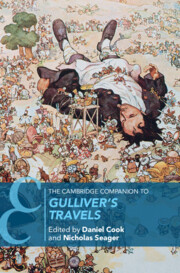Book contents
- The Cambridge Companion to Gulliver’s Travels
- The Cambridge Companion to Gulliver’s Travels
- Copyright page
- Contents
- Figures
- Notes on Contributors
- Abbreviations
- Note on the Text
- Chronology
- Introduction
- Part I Contexts
- Chapter 1 Politics
- Chapter 2 Religion
- Chapter 3 Bodies and Gender
- Chapter 4 Science, Empire, and Observation
- Part II Genres
- Part III Reading Gulliver’s Travels
- Part IV Afterlives
- Further Reading
- Index
- Cambridge Companions to Literature
Chapter 3 - Bodies and Gender
from Part I - Contexts
Published online by Cambridge University Press: 05 October 2023
- The Cambridge Companion to Gulliver’s Travels
- The Cambridge Companion to Gulliver’s Travels
- Copyright page
- Contents
- Figures
- Notes on Contributors
- Abbreviations
- Note on the Text
- Chronology
- Introduction
- Part I Contexts
- Chapter 1 Politics
- Chapter 2 Religion
- Chapter 3 Bodies and Gender
- Chapter 4 Science, Empire, and Observation
- Part II Genres
- Part III Reading Gulliver’s Travels
- Part IV Afterlives
- Further Reading
- Index
- Cambridge Companions to Literature
Summary
The portrayal of male and female bodies in Gulliver’s Travels has long been the subject of critical debate, from early suggestions that Swift was motivated by personal animus against Maids of Honour to more recent studies characterising him as an inveterate misogynist or an effeminised admirer of women. This chapter suggests that the depictions of female bodies must be read alongside Gulliver’s preoccupation with his own body and its functions, and these representations should be understood in the context of a culture in which sexuality provided a recognised shorthand for political debate. The aristocratic rakish discourse of Restoration theatre, with its presentation of relations between men and women through metaphors of battle and struggle, was being challenged by the emergence of sentimental dramas celebrating marital harmony. Gulliver’s horror at female bodies and his idealisation of the social systems of Lilliput and Houyhnhnmland challenge the fetishisation of the family and reverence for domesticity that were increasingly characterising moral discourse and found their ideal form for expression in the development of the novel.
- Type
- Chapter
- Information
- The Cambridge Companion to Gulliver's Travels , pp. 34 - 45Publisher: Cambridge University PressPrint publication year: 2023

